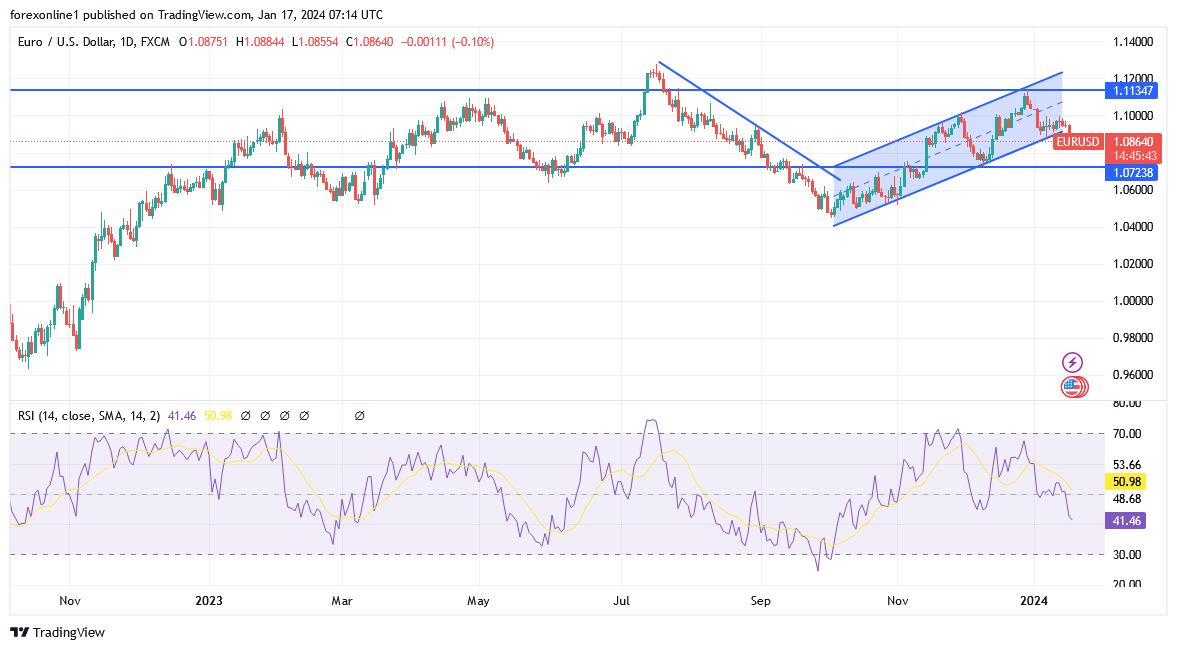- Demand for the US dollar as a haven has increased amid rising global geopolitical tensions, as well as the calming of expectations about the future of US interest rate cuts soon.
- Consequently, the EUR/USD pair has been subject to strong selling pressure, with losses extending to the support level of 1.0862, the pair’s lowest level in over a month.
- Currently, it is stabilizing around its losses at the start of the Wednesday session, which includes several important economic data from the eurozone and the United States.

Selling of the euro has increased after hints from European Central Bank officials warning that interest rate cuts are not guaranteed this year. In this regard, according to ECB board member Robert Holzmann, the threats posed by continued inflation will prevent the European Central Bank from cutting interest rates this year – even with the possibility of a recession not being ruled out.
Holzmann added in an interview in Davos, Switzerland, where he is attending the World Economic Forum, that the eurozone economy has disappointed recently, and it is likely that officials will prove to be too optimistic once the fourth-quarter results are released. At the same time, geopolitical conflicts – such as those in the Middle East – threaten to disrupt supply chains and energy markets, leading to continued price pressures that the European Central Bank cannot ignore. Also, Holzmann said, “The geopolitical threat has increased because what we have seen so far from the Houthis – I think it is not the end, and it could open up to something much broader, which would affect the Suez Canal and increase prices there.” Ended by, “we should not rely on interest rate cuts at all for 2024.”
Overall, inflation approached the European Central Bank's 2% target late last year, raising speculation about when policymakers would reverse the biggest monetary tightening campaign since the introduction of the euro 25 years ago. Therefore, traders are betting on cuts of six-quarter percentage points, starting in April, while economists expect the first of four steps to take place in June.
Meanwhile, Holzmann reiterated the point made by colleagues including ECB President Christine Lagarde and chief economist Philip Lane – that it is “too early” to talk about lowering borrowing costs. “Once such a date is set, it will immediately trigger dynamics that we cannot control,”. Holzmann, who also heads the Austrian Central Bank added, “With all the knowledge we currently have, it would not be honest to do that because we do not know how inflation will develop.”
Top Forex Brokers
Speaking yesterday to Bloomberg TV, Bundesbank President Joachim Nagel agreed that it was too early to discuss monetary easing, suggesting no action before the summer. “Maybe we can wait until the summer vacation or something else, but I don’t want to speculate,”. Moreover, he said in Davos, stressing that officials will still rely on the data. “I think it is too early to talk about cuts.” Currently, the ECB expects headline inflation to reach 2% in the second half of 2025, while core price pressures are expected to remain above this limit until the end of 2026.
For his part, Holzman described the recent trend as a “sideways movement” and warned that it may continue. Furthermore, wage demands have not yet fallen, and some recent bargaining agreements in Germany, Austria and the Netherlands indicate “very high” increases. This is despite the weak economy. Yesterday, Germany announced a 0.3% contraction in the fourth quarter and a decline in production of the same size for the whole of 2023. Ultimately, Holtzman said the board's assessment has become "somewhat more skeptical" over the past months. Eurozone fourth-quarter data will be published on January 30, and he also said he feared “we will also be a little less optimistic” after that. While the region is not expected to fall into a “real recession,” it could easily succumb to a recession “caused by external influences.” He added, “If geopolitical risks lead to higher oil prices, gas prices will rise sharply, and this will also affect a number of industries that have already been affected.” Maybe even the service industry.” Finally, “Then, recession is not unlikely.”
EUR/USD Technical Analysis and Forecast:
According to the performance on the daily chart above, the bears’ control over the direction of the price of the currency pair EUR/USD has increased. Technically, breaking the support 1.0880 supports a bearish shift and may push the currency pair towards new buying levels, the closest of which are currently 1.0845 and 1.0760, respectively. Considering the last level will push the technical indicators towards strong saturation levels for selling. On the other hand, over the same period, there will be an opportunity for the bulls to take control if it returns to the 1.1000 psychological resistance area again. Today, the EUR/USD will react by announcing inflation numbers in the Eurozone, then US retail sales numbers, and statements by some US Central Bank policy officials.
Ready to trade our Forex daily forecast? We’ve shortlisted the best currency trading platforms in the industry for you.
